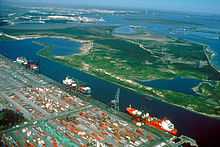Wharf


A wharf, quay (/ˈkiː/, also /ˈkeɪ/ or /ˈkweɪ/[1]), staith or staithe is a structure on the shore of a harbour or on the bank of a river or canal where ships may dock to load and unload cargo or passengers.[2] Such a structure includes one or more berths (mooring locations), and may also include piers, warehouses, or other facilities necessary for handling the ships.
Overview
A wharf commonly comprises a fixed platform, often on pilings. Commercial ports may have warehouses that serve as interim storage areas, since the typical objective is to unload and reload vessels as quickly as possible. Where capacity is sufficient a single wharf with a single berth constructed along the land adjacent to the water is normally used; where there is a need for more capacity multiple wharves, or perhaps a single large wharf with multiple berths, will instead be constructed, sometimes projecting into the water. A pier, raised over the water rather than within it, is commonly used for cases where the weight or volume of cargos will be low.
Smaller and more modern wharves are sometimes built on flotation devices (pontoons) to keep them at the same level as the ship, even during changing tides.
In everyday parlance the term quay is common in the United Kingdom, Canada, Australia, and many other Commonwealth countries, and the Republic of Ireland, whereas the term wharf is more common in the United States. In some contexts wharf and quay may be used to mean pier, berth, or jetty.
In old ports such as London (which once had around 1700 wharves [3]) many old wharves have been converted to residential or office use.
-

King Henry's Wharves, typical London wharves converted to apartments
-

Wharf by Marriott/Pacquereau Bay on St. Thomas
-
_arp.jpg)
Tourist boat loading passengers at a small quay, Sa Calobra, Majorca, Spain
Etymology
The word wharf comes from the Old English hwearf, meaning "bank" or "shore", and its plural is either wharfs or wharves; collectively a group of these is referred to as a wharfing or wharfage. "Wharfage" also refers to a fee charged by ports for the cargo handled there.
In the northeast and east of England the term staithe or staith (from the Norse for landing stage) is also used. For example Dunston Staiths in Gateshead and Brancaster Staithe in Norfolk. However, the term staithe may also be used to refer only to loading chutes or ramps used for bulk commodities like coal in loading ships and barges. It has been suggested that wharf actually is an acronym for ware-house at river front,[4][5] but it is actually a backronym created by Thames river boat guides.
Another explanation may be that the word wharf comes from the Saxon word "warft" or the Dutch word "werf" which both mean "yard", an outdoor place where work is done, like a shipyard (Dutch: scheepswerf) or a lumberyard (Dutch: houtwerf). This could explain the name Ministry Wharf located at Saunderton, just outside High Wycombe, which is nowhere near any body of water. In support of this explanation is the fact that many places in England with "wharf" in their names are in areas with a high Dutch influence, for example the Norfolk broads.
See also
References
- ↑ "Quay - Definition and More from the Free Merriam-Webster Dictionary". Merriam-webster.com. 2012-08-31. Retrieved 2012-10-19.
- ↑ "Quay". American Heritage Dictionary/Dictionary.com. Retrieved 8 Feb 2010.
"Wharf". American Heritage Dictionary/Dictionary.com. Retrieved 8 Feb 2010. - ↑ Craig, Charles; Diprose, Graham; Seaborne, Mike (2009). London's Changing Riverscape. London: Frances Lincoln Ltd. ISBN 978-0-7112-2941-9.
- ↑ "Chav... [page 4]". London-se1.co.uk. Retrieved 2012-10-19.
- ↑ "Word wharf meaning. Word wharf definition. Free crossword dictionary". Wordnavigator.com. Retrieved 2012-10-19.
External links
| Wikimedia Commons has media related to Wharves and quays. |
-
 The dictionary definition of wharf at Wiktionary
The dictionary definition of wharf at Wiktionary
| ||||||||||||||||||||||||||||||